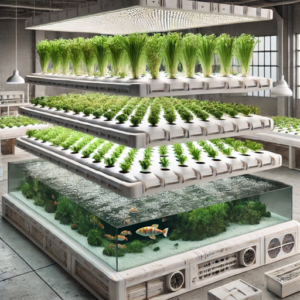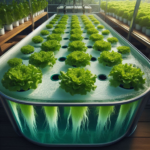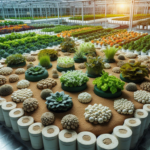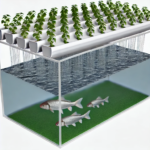What Are the Most Efficient Aquaponics Systems? As someone who’s got one foot in a fish tank and the other in a grow bed (metaphorically, of course!), I often get asked about the most efficient aquaponics systems. It’s a fantastic question because, let’s face it, if you’re putting fish and plants together, you want them to work in harmony—not like they’re at an awkward family reunion. So, in this article, I’ll dive into the most efficient systems I’ve encountered and how you can get the most bang for your aquatic buck.
Understanding Aquaponics Systems
What is Aquaponics?
Before we dive into efficiency, let’s make sure we’re all swimming in the same water. Aquaponics is like the ultimate power couple of farming—fish, and plants working together. The fish produce waste, which, after some bio-magic, turns into nutrients for the plants. The plants, in turn, help filter and clean the water for the fish. It’s like Mother Nature’s version of teamwork. Go, team!
Benefits of Aquaponics
Aquaponics isn’t just a clever way to grow food—it’s a sustainable one too. You save water, grow organic produce, and can do all this in a compact space. It’s basically farming for the 21st century, minus the tractor and overalls (unless you’re into that Kind of thing).
The Most Efficient Aquaponics Systems
Alright, let’s get to the fun part. Here are the most efficient systems I’ve come across, based on years of playing matchmaker between fish and plants.
Deep Water Culture (DWC) System 
How It Works
The Deep Water Culture system—also known as the “raft system,” which makes it sound way more chill than it actually is—lets plants float on top of a large tank of water. Their roots hang out like they’re at a pool party, soaking up the nutrient-rich water below.
Why It’s Great
I’m a big fan of DWC because:
-
-
- You can pack in a ton of plants.
- The large water volume means your fish don’t freak out every time something changes.
- Harvesting is as easy as lifting a raft. Just don’t wear your best shoes around that water.
-
Media-Based Systems 
What’s the Media?
In a media-based system, plants grow in some sort of material—expanded clay, gravel, or other mediums that sound like they belong in a garden rock concert. The media also doubles as a biofilter, breaking down fish waste and turning it into plant food.
Why You’ll Love It
Here’s why media-based systems are awesome:
-
-
- You can grow a wide variety of plants.
- The media helps keep your water clean, which means happy fish.
- Once it’s set up, it’s pretty low-maintenance—like a goldfish with extra responsibilities.
-
Nutrient Film Technique (NFT) 
How NFT Rolls
No, this isn’t about digital art. In the aquaponics world, NFT stands for Nutrient Film Technique. Plants grow in channels with a thin film of nutrient-filled water flowing under them. The roots hang just low enough to get the nutrients they need without drowning. Sounds like a delicate balance, right? It is, but when done right, it’s chef’s kiss efficient.
Pros of NFT Systems
-
-
- It uses less water than most systems (great for those who like efficiency on a budget).
- Ideal for leafy greens and herbs—you know, the salad bar types.
- It is super space-efficient and can even be stacked vertically for that skyscraper-garden vibe.
-
Factors That Affect Efficiency
Choosing a system is only half the battle. To truly achieve efficiency, you’ve got to consider a few key factors. Let’s break them down.
Water Quality Management
Maintaining pristine water is crucial. Think of it like managing a tiny aquatic ecosystem where everyone has very particular needs. Regularly check your water’s pH, ammonia, nitrite, and nitrate levels. A good biofilter is like the system’s personal spa—it keeps everything balanced and happy.
Fish-to-Plant Ratio
Here’s where it gets tricky. Too many fish and you’ll have more waste than your plants can handle. Too few, and your plants will be asking, “Where’s the food?” A good rule of thumb is a fish tank volume-to-grow bed ratio of 1:2 or 1:3. Kind of like keeping a Goldilocks vibe—not too much, not too little, just right.
Environmental Control
Like your plants and fish? Great. Now, they love their environment, too. Keeping the right temperature, humidity, and light levels will boost efficiency. Greenhouses or indoor setups can help you control the elements like a farming wizard, ensuring happy fish and thriving plants year-round.
Optimizing Your System
Running a smooth aquaponics system isn’t just set-it-and-forget-it. You’ll need to be a little hands-on, but it’s nothing a dedicated enthusiast like you can’t handle.
Monitoring and Maintenance
Just like your car needs oil changes, your aquaponics system needs a little TLC:
-
- Check water levels and fish behavior daily (and yes, the fish will start to recognize you).
- Test water quality weekly.
- Give your filters and pumps a deep clean monthly to keep everything flowing smoothly.
Choosing the Right Fish and Plants
Some fish and plant combos are the aquaponics equivalent of peanut butter and jelly. Here are a few fan-favorites:
-
- Tilapia + Leafy Greens: They’re like the dynamic duo of aquaponics—easygoing and productive.
- Trout + Herbs: Perfect for cooler water setups, and trout can add a little pizzazz to your pond.
- Catfish + Fruiting Plants: These guys are hearty and pair well with tomatoes and peppers if you’re going for something more robust.
Conclusion
In my experience, efficiency in aquaponics isn’t just about how much food you can grow. It’s about creating a balanced system where both fish and plants thrive while using minimal resources. Whether you opt for a DWC, media-based, or NFT setup, remember that efficiency is all about planning, adjusting, and learning as you go.
And hey, don’t just think of this as a way to grow food—it’s a way to grow smarter. By focusing on efficiency, you’re not just feeding yourself; you’re helping to create a more sustainable future. Plus, your fish will totally appreciate it. What Are the Most Efficient Aquaponics Systems?
FAQs
- How often should I clean my aquaponics system?
Think of your system like a well-oiled machine. Filters should get a weekly scrub and give the whole thing a monthly deep clean. - Can I mix different types of fish?
Sure, but it’s Kind of like throwing a bunch of people with different food allergies into one dinner party—risky. It’s best to stick with one species unless you’re a pro. - What’s the best plant for beginners?
Lettuce. It’s fast-growing, low-maintenance, and doesn’t throw tantrums if the water quality dips for a day or two. - How long does it take for a system to cycle?
Patience, my friend. A new system usually takes 4-6 weeks to cycle and build up beneficial bacteria. - Can I do aquaponics indoors?
Absolutely! Indoor setups are not only possible, but they can be incredibly efficient with the proper lighting and environmental control.






